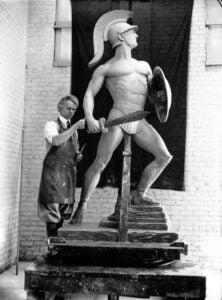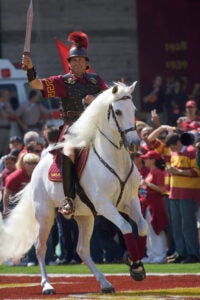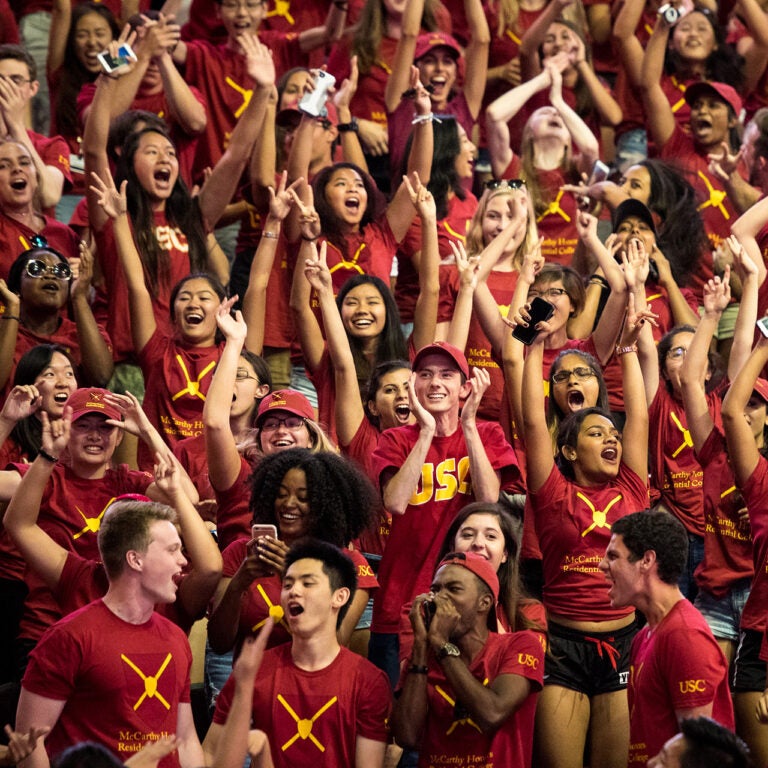USC Traditions
Trojan Shrine
 Sculpted by Roger Noble Burnham, Tommy Trojan was modeled after different USC football players. On the bronze statue’s granite pedestal are inscribed the qualities of the ideal Trojan: “FAITHFUL, SCHOLARLY, SKILLFUL, COURAGEOUS, AMBITIOUS.”
Sculpted by Roger Noble Burnham, Tommy Trojan was modeled after different USC football players. On the bronze statue’s granite pedestal are inscribed the qualities of the ideal Trojan: “FAITHFUL, SCHOLARLY, SKILLFUL, COURAGEOUS, AMBITIOUS.”
On the Drawn Sword of Tommy Trojan
By Norman Corwin
Presented in Bovard Auditorium on the occasion of the public announcement of the Campaign for USC, September 26, 1986
There is on this campus, not far from where you are sitting, a sculpture of a young man. He stands with an outthrust sword in his right hand and a raised shield in his left, and he obviously means business.
For more than half a century he has been the inseparable symbol of this university. But this morning, when we meet to consider ourselves, and what we do, and how well we do it, it is perhaps not idle to ask just what that Trojan symbolizes. He’s a warrior, but this is not a military academy. He has a noble mien; he is beautiful; he is confidently poised to attack or defend – but exactly who is the adversary, and from what quarter does he come? If we look for clues on the pedestal of the sculpture, we find two lines of poetry in the Latin of Virgil, which translate:
Here are provided seats of meditative joy
Where shall arise again the destined reign of Troy.
The trouble is, seats of meditative joy don’t quite go with the stance of an armed and powerfully muscled fighter, so we have to look further; and we find another sentence in Latin, this one unattributed. It translates, “Let him bear the palm, who deserves it.” Nobody can quarrel with that, but it doesn’t help answer our question. Next are five adjectives in English, strung out with nothing to modify: “Faithful, scholarly, skillful, courageous, ambitious” Not much help there either.
Ah, but there are also two panels of bas-reliefs of human figures. The first depicts four athletes, representing basketball, running, wrestling, and discus- throwing. (Not football, strangely, but then how could a sculptor 56 years ago foresee … that incredible 1974 win over Notre Dame?)
All right – a remaining panel is crowded with seven figures, representing medicine, engineering and five other useful disciplines. Still, in all this, there is no identifiable enemy arrayed against Tommy Trojan – and remember, he is the logo, the signature, the blazoned emblem of this university. And symbols, I hardly need say, have importance; they can be sacred – a flag, a cross, a star, a crescent moon.
I think the answer to the question is that our militant young man, as well as his implied foe, stand for whatever we want to read into them. I’m sure I’m not alone in perceiving Tommy Trojan’s symbolic enemies to be not Greeks bearing gifts or Huns bearing arms, but the far more menacing, because far more subtle and invidious, enemies of ignorance, indifference, greed, mediocrity, prejudice, complacency, boredom, eroded values, low expectations, and ravenous hungering for sensation.
It seems to me that the whole process of civilization is what we read into things. What is philosophy, what is morality, what is law, what is religion, except what each reads into life and into the knowledge of life? What indeed is the character of a university, except what, collectively, it reads into the process of education itself, into the arts and sciences, into the professions, into commerce, into government, into the ponderous and fateful issues of war and peace?
Norman Corwin (1910-2011) was a familiar and honored teacher at USC from 1979 until the end of his life. Over the course of his decades-long career in writing for radio, television, stage, film and print, he garnered numerous writing awards, including a best-screenplay Academy Award nomination, an Emmy, the Peabody Medal and the Valentine Davies Award of the Writers Guild of America. He was the first writer admitted to the Radio Hall of Fame. A documentary on his life, A Note of Triumph: The Golden Age of Norman Corwin, won an Academy Award.
Traveler
 Traveler, the noble white horse that appears at all USC home football games with a Trojan warrior astride, is one of the most famous college mascots.
Traveler, the noble white horse that appears at all USC home football games with a Trojan warrior astride, is one of the most famous college mascots.
Traveler first made an appearance at USC football games in 1961 in the home opener versus Georgia Tech. Bob Jani, USC’s director of special events, and Eddie Tannenbaum, a junior at USC, had spotted Richard Saukko riding his white horse, Traveler I, in the 1961 Rose Parade. They persuaded Saukko to ride his white horse around the Coliseum during USC games, serving as a mascot. Ever since, whenever USC scores, the band plays “Conquest” and Traveler gallops around the Coliseum.
The Traveler tradition began in 1961 with Traveler I. From 1961 to 1988, USC’s equestrian mascots were selected, trained and ridden by Richard Saukko. After his death, the Saukko family continued the tradition of raising the famous Trojan horses until 2003, when equestrian manager Joanne Asman took over.
The Traveler statue located across from Tommy Trojan in Hahn Plaza on campus was a gift from Steven and Kathryn Sample and was unveiled on May 4, 2010. The statue is bronze with a white patina modeled after the pure white Andalusian horse that is our majestic mascot, Traveler.
USC’s mascot horse is a symbol of ancient Troy. Its rider, with costume and sword, is a symbol of a Trojan warrior. The name Traveler, spelled with one “l”, is a common name among horses. One example is the foundation sire for the entire American Quarter Horse breed who died in 1912 and was inducted into the quarter horse hall of fame in 1994. USC’s Traveler is and has always been a proud symbol of Troy. There is no truth to any other claims or rumors about its name.
Motto
Palmam Qui Meruit Ferat
USC’s motto, Palmam Qui Meruit Ferat, can be loosely translated from the Latin as “let whoever earns the palm bear it.” The expression reflects the broad significance of palms, palm fronds and other branches of foliage as symbols of triumph, victory, ascension and regeneration in ancient times, and in particular may allude to the Roman custom of giving the victorious gladiator a palm branch as reward for prowess.
One of the earliest references to the phrase is found in a small volume of Latin verse, titled Lusus Poetici, which was first published by English theologian John Jortin in 1722. Decades later, it became widely known as the personal motto of Horatio Nelson, a British naval hero who distinguished himself during the Napoleonic Wars. In 1798, after a spectacular victory over Napoleon at the Battle of the Nile, Nelson was granted the title of Baron Nelson of the Nile, and the words PALMAM QUI MERUIT FERAT were added to his coat of arms.
“Let whoever earns the palm bear it.”
Over time, the saying has been used as a watchword by diverse organizations ranging from athletic clubs to educational institutions such as the British Royal Naval School and other military academies as well as high schools, preparatory schools, and colleges and universities around the world. USC adopted the motto in 1908, when it was incorporated into the design of a new university seal.
Alluding as it does to accomplishment, righteousness and victory, USC’s motto speaks to qualities that are as inherent to the university today as they were in 1908. By holding fast to its foundational self-reliance, “we-can-do-more” spirit and steadfast commitment to open access for all students of merit, the University of Southern California indeed has earned the palm. Although it is less than half their age, USC ranks among a peer group of U.S. universities that includes Princeton and Yale. But USC is not content to rest upon its laurels. As former USC president Steven B. Sample put it: “USC is characterized by a keen desire to do even more tomorrow no matter how much we may have accomplished today.” USC has set its sights on becoming the worldwide paradigm for the research university of the 21st century. That goal is yet another palm, and USC is determined to earn it.
Alma Mater
All Hail to Alma Mater
To thy glory we sing;
All Hail to Southern California
Loud let thy praises ring;
Where Western sky meets Western sea
Our college stands in majesty;
Sing our love to Alma Mater,
Hail, all hail to thee!
Since its founding in 1880, USC has had two alma maters. The first, also known as the “University Hymn,” was written by John Oliver Wilson ’08 and had four verses. The second – and current – alma mater is Alfred F. Wesson’s “All Hail.”
In the early 1920s, Wesson ’24, a journalism major and a trumpet player in the Trojan Marching Band, penned the musical numbers for a student fundraiser called Campus Frolics of 1923.
Frolics was a comedy, poking fun at university life, and Wesson decided “it would be a good idea to wind up with something more stately and serious” to show that even though they were ribbing the university, the students “really did love it.”
So, as he told Los Angeles Times sports commentator Sid Ziff in 1965: “I wrote something stuffy. I wrote a thing called ‘All Hail.’” Wesson claimed the inspiration came to him on a streetcar when, as managing editor for the school paper, he was on his way downtown to deliver page proofs.
Wesson was modest about his musical achievements. He called himself the “world’s worst trumpet player,” for example, even though his skill in reading music garnered him gigs that helped put him through college.
Similarly, he never dreamed his song would last. Yet almost immediately after its debut, his classmate Frank Lanterman, who had done the arrangement and also served as the university’s organist, began playing “All Hail” at the end of chapel hour. The song quickly superseded Wilson’s “University Hymn” in the hearts and minds of the student body, and it remains USC’s official alma mater to this day.
What’s more, “Cardinal and Gold” – the song Wesson wrote for the opening of the Frolics – also became a perennial favorite, played at Trojan football games and countless other university events.
Like his music, Wesson, too, had staying power at USC. He served as the university’s first full-time sports information director from 1928 to 1942. (He left USC to serve in World War II, and later became publicity director for Hollywood Park.)
Wesson also co-authored books with two of USC’s most legendary coaches: Football for the Fan with Howard Jones, and Championship Technique in Track and Field: A Book for Athletes, Coaches and Spectators with Dean Cromwell.
University Seal
The University of Southern California’s original seal was developed in 1884 to emboss the diplomas of the school’s first graduating class. This seal depicted the year of USC’s founding (1880) emblazoned on a scroll next to a palm tree (in heraldry, a symbol of righteousness and victory), with the name of the institution inscribed around the border.
In 1908, Jesse Ray Miller devised a new seal that introduced USC’s official flower, the California poppy, a heraldic symbol of remembrance, hope, joy and growth. The seal also included a shield bearing a setting sun and three torches. In heraldic tradition, the torch symbolizes learning, and the three torches displayed here represented learning in the arts, the sciences and philosophy. The sun signified the West and, according to heraldic symbolism, power and life. Finally, enfolding the shield was a scroll displaying the university’s new motto, “palmam qui meruit ferat.”
In 1948, the USC Board of Trustees approved an updated version of the university seal. In this version, the poppies appear next to the shield inside of the outer band, which is now formatted as a scroll, and the Latin motto is emblazoned on a separate scroll at the base of the seal. This seal continues to be the imprimatur, or official signature, of USC to this day.
Official Fight Song
Fight On for ol’ SC
Our men Fight On to victory.
Our Alma Mater dear, looks up to you
Fight On and win for ol’ SC
Fight On to victory. Fight On!
Trojan Marching Band
Known as the Spirit of Troy, the Trojan Marching Band has performed at the Academy Awards, the Hollywood Bowl, the Rose Parade, and in numerous film and television productions. In 1979, the band recorded the title track for the album Tusk with the rock group Fleetwood Mac, which resulted in a platinum album for that song; no other collegiate marching band has ever been so honored.



